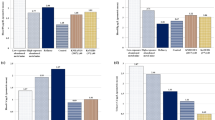Abstract
This cross-sectional study aimed to investigate blood mercury (B-Hg) concentration of residents living in the vicinity of Chatian mercury mine (CMM) in southwestern China and to assess the possible effects on renal function. It evaluates the effects of gender and age (children, <18 years; adults, 18–60 years; elderly, >60 years) on the B-Hg and serum creatinine (SCR) and serum urea nitrogen (SUN) levels. In the CMM, elevated levels were found for B-Hg, SCR, and SUN with mean values at 6.09 μg/L, 74.21 μmol/L, and 13.26 mmol/L, which were significantly higher than those in the control area, respectively. Moreover, the coefficients between paired results for B-Hg and SCR and SUN levels were positive at statistical significance (B-Hg vs. SCR, r = 0.45, p < 0.01; B-Hg vs. SUN, r = 0.20, p < 0.05). The aforementioned results revealed that mercury exposure can cause human renal function impairment. B-Hg, SCR, and SUN can also be useful biomarkers to assess the extent of mercury exposure among residents in areas with extensive mining activities. Furthermore, data analysis revealed that there was a tendency for higher B-Hg, SCR, and SUN levels in females than in males, and the levels of B-Hg, SCR, and SUN increased among the older residents. We conclude that females and the elderly in the mining area were more susceptible to mercury exposure, and therefore, they deserve further research.

Similar content being viewed by others
References
Agah, H., Leermakers, M., Gao, Y., Fatemi, S. M. R., Katal, M. M., Baeyens, W., et al. (2011). Mercury accumulation in fish species from the Persian Gulf and in human hair from fishermen. Environmental Monitoring and Assessment, 169, 203–216.
ATSDR. (1999). Toxicological profile for mercury. http://www.atsdr.cdc.gov/toxprofiles/tp46.pdf. Accessed 25 September 2011.
Augusti, P. R., Conterato, G. M. M., Somacal, S., Sobieski, R., Spohr, P. R., & Torres, J. V. (2008). Effect of astaxanthin on kidney function impairment and oxidative stress induced by mercuric chloride in rats. Food and Chemical Toxicology, 46, 212–219.
Bárány, E., Bergdahl, I. A., Bratteby, L., Lundh, T., Samuelson, G., & Schütz, A. (2002). Trace element levels in whole blood and serum from Swedish adolescents. Science of the Total Environment, 286, 129–141.
Barbosa, A. C., Garcia, A. M., & de Souza, J. R. (1997). Mercury contamination in hair of riverine populations of Apiacas Reserve in the Brazilian Amazon. Water, Air, and Soil Pollution, 97, 1–8.
Becker, C. G., Becker, E. L., Maher, J. F., & Schreiner, G. E. (1962). Nephrotic syndrome after contact with mercury. Archives of Internal Medicine, 110, 82–90.
Becker, K., Kaus, S., Krause, C., Lepom, P., Schulz, C., & Seiwert, M. (2002). German environmental survey (GerES III): Environmental pollutants in blood of the German population. International Journal of Hygiene and Environmental Health, 205, 297–308.
Budtz-Jørgensen, E., Grandjean, P., Jørgensen, P. J., Weihe, P., & Keiding, N. (2004). Association between mercury concentrations in blood and hair in methylmercury-exposed subjects at different ages. Environmental Research, 95, 385–393.
Caldwell, K. L., Mortensen, M. E., Jones, R. L., Caudill, S. P., & Osterloh, J. D. (2009). Total blood mercury concentrations in the U.S. population: 1999–2006. International Journal of Hygiene and Environmental Health, 212, 588–598.
Cheng, J., Yang, Y., Ma, J., Wang, W., Liu, X., & Sakamoto, M. (2009). Assessing noxious effects of dietary exposure to methylmercury, PCBs and Se coexisting in environmentally contaminated rice in male mice. Environment International, 35, 619–625.
Clark, N. A., Teschke, K., Rideout, K., & Copes, R. (2007). Trace element levels in adults from the west coast of Canada and associations with age, gender, diet, activities, and levels of other trace elements. Chemosphere, 70, 155–164.
Cortes-Maramba, N., Reyes, J. P., Francisco-Rivera, A. T., Akagi, H., Sunio, R., & Panganiban, L. C. (2006). Health and environmental assessment of mercury exposure in a gold mining community in Western Mindanao, Philippines. Journal of Environmental Management, 81, 126–134.
Crompton, P., Ventura, A. M., de Souza, J. M., Santos, E., Strickland, G. T., & Silbergeld, E. (2002). Assessment of mercury exposure and malaria in a Brazilian Amazon riverine community. Environmental Research, 90, 69–75.
Drasch, G., Böse-O’Reilly, S., Beinhoff, C., Roider, G., & Maydl, S. (2001). The Mt. Diwata study on the Philippines 1999―assessing mercury intoxication of the population by small scale gold mining. Science of the Total Environment, 267, 151–158.
Emanuelli, T., Rocha, J. B. T., Pereira, M. E., Porciúncula, L. O., Morsch, V. M., & Martins, A. F. (1996). Effect of mercuric chloride intoxication and dimercaprol treatment on delta-aminolevulinate desidratase from brain, liver and kidney of adult mice. Pharmacology & Toxicology, 79, 136–143.
Feng, X., Li, P., Qiu, G., Wang, S., Li, G., Shang, L., et al. (2008). Methylmercury exposure through rice intake to inhabitants in Wanshan mercury mining area in Guizhou, China. Environmental Science and Technology, 42, 326–332.
Fowler, B. A. (1972). Ultrastructural evidence for nephropathy induced by long-term exposure to small amounts of methyl mercury. Science, 175, 780–781.
Horvat, M., Nolde, N., Fajon, V., Jereb, V., Logar, M., & Lojen, S. (2003). Total mercury, methylmercury and selenium in mercury polluted areas in the province Guizhou, China. Science of the Total Environment, 304, 231–256.
Howard, J., Trotz, M. A., Thomas, K., Omisca, E., Chiu, H. T., Halfhide, T., et al. (2011). Total mercury loadings in sediment from gold mining and conservation areas in Guyana. Environmental Monitoring and Assessment, 179, 555–573.
Karimi, A., Moniri, F., Nasihatkon, A., Zarepoor, M. J., & Alborzi, A. (2002). Mercury exposure among residents of a building block in Shiraz, Iran. Environmental Research, 88, 41–43.
Kim, N. S., & Lee, B. K. (2010). Blood total mercury and fish consumption in the Korean general population in KNHANES III, 2005. Science of the Total Environment, 408, 4841–4847.
Kristiansen, J., Christensen, J. M., Iversen, B. S., & Sabbioni, E. (1997). Toxic trace element reference levels in blood and urine: Influence of gender and lifestyle factors. Science of the Total Environment, 204, 147–160.
Laks, D. R. (2009). Assessment of chronic mercury exposure within the U.S. population, National Health and Nutrition Examination Survey, 1999–2006. Biometals, 22, 1103–1114.
Langworth, S., Elinder, C. G., Göthe, C. J., & Vesterberg, O. (1991). Biological monitoring of environmental and occupational exposure to mercury. International Archives of Occupational and Environmental Health, 63, 161–167.
Li, P., Feng, X., Qiu, G., Li, Z., Fu, X., Sakamoto, M., et al. (2008). Mercury exposures and symptoms in smelting workers of artisanal mercury mines in Wuchuan, Guizhou, China. Environmental Research, 107, 108–114.
Li, Y., Yang, L., Ji, Y., Sun, H., & Wang, W. (2009). Quantification and fractionation of mercury in soils from the Chatian mercury mining deposit, Southwestern China. Environment Geochemistry and Health, 31, 617–628.
Li, Y., Yang, L., Wang, W., Li, H., Lv, J., & Zou, X. (2011). Trace element concentrations in hair of healthy Chinese centenarians. Science of the Total Environment, 409, 1385–1390.
Misztal-Szkudlińska, M., Szefer, P., Konieczka, P., & Namieśnik, J. (2011). Biomagnification of mercury in trophic relation of Great Cormorant (Phalacrocorax carbo) and fish in the Vistula Lagoon, Poland. Environmental Monitoring and Assessment, 176, 439–449.
Mitsumori, K., Hirano, M., Ueda, H., Maita, K., & Shirasu, Y. (1990). Chronic toxicity and carcinogenicity of methylmercury chloride in B6C3F1 mice. Fundamental and Applied Toxicology, 14, 179–190.
NRC. (2000). Toxicological effects of methylmercury. Washington, DC: National Academy Press.
Ohno, T., Sakamoto, M., Kurosawa, T., Dakeishi, M., Iwata, T., & Murata, K. (2007). Total mercury levels in hair, toenail, and urine among women free from occupational exposure and their relations to renal tubular function. Environmental Research, 103, 191–197.
Qiu, G., Feng, X., Wang, S., Wang, S., & Shang, L. (2006). Environmental contamination of mercury from Hg-mining areas in Wuchuan, northeastern Guizhou, China. Environmental Pollution, 142, 549–558.
Reis, M. F., Sampaio, C., Brantes, A., Aniceto, P., Melim, M., & Cardoso, L. (2007). Human exposure to heavy metals in the vicinity of Portuguese solid waste incinerators—Part 1: Biomonitoring of Pb, Cd and Hg in blood of the general population. International Journal of Hygiene and Environmental Health, 210, 439–446.
Rumbeiha, W. K., Fitzgerald, S. D., Braselton, W. E., Roth, R. A., Pestka, J. J., & Kaneene, J. B. (2000). Augmentation of mercury-induced nephrotoxicity by endotoxin in the mouse. Toxicology, 151, 103–116.
Son, J. Y., Lee, J., Paek, D., & Lee, J. T. (2009). Blood levels of lead, cadmium, and mercury in the Korean population: Results from the second Korean national human exposure and bio-monitoring examination. Environmental Research, 109, 738–744.
Steckling, N., Boese-O'Reilly, S., Gradel, C., Gutschmidt, K., Shinee, E., & Altangerel, E. (2011). Mercury exposure in female artisanal small-scale gold miners (ASGM) in Mongolia: An analysis of human biomonitoring (HBM) data from 2008. Science of the Total Environment, 409, 994–1000.
Tubbs, R. R., Gephardt, G. N., McMahon, J. T., Pohl, M. C., Vidt, D. G., & Barenberg, S. A. (1982). Membranous glomerulonephritis associated with industrial mercury exposure. American Journal of Clinical Pathology, 77, 409–413.
Zalups, R. K. (1997). Reductions in renal mass and the nephropathy induced by mercury. Toxicology and Applied Pharmacology, 143, 366–379.
Zhang, L., & Wong, M. H. (2007). Environmental mercury contamination in China: Sources and impacts. Environment International, 33, 108–121.
Zhang, H., Feng, X., Larssen, T., Qiu, G., & Vogt, R. (2010). In inland China, rice, rather than fish is the major pathway for methylmercury exposure. Environmental Health Perspectives, 118, 1183–1188.
Acknowledgments
This work was supported by the Key Project of the Knowledge Innovation Program of IGSNRR (2012ZD002) and the National Science Foundation of China (41040014; 40571008), and the SSRC Collaborative Grants Program supported by the Rockefeller Brothers Fund. The authors are also thankful to Dr. Anna Lora-Wainwright from University of Oxford for reviewing the final draft.
Author information
Authors and Affiliations
Corresponding author
Rights and permissions
About this article
Cite this article
Li, Y., Zhang, B., Yang, L. et al. Blood mercury concentration among residents of a historic mercury mine and possible effects on renal function: a cross-sectional study in southwestern China. Environ Monit Assess 185, 3049–3055 (2013). https://doi.org/10.1007/s10661-012-2772-0
Received:
Accepted:
Published:
Issue Date:
DOI: https://doi.org/10.1007/s10661-012-2772-0




